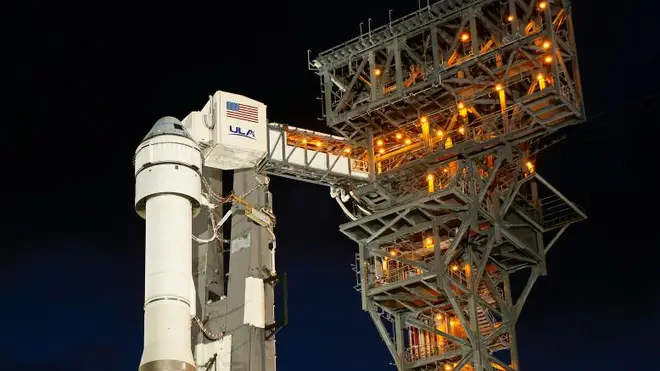
Oli Dugmore 4am - 7am
20 December 2019, 11:56
Boeing's new Starliner space capsule has run into trouble whilst attempting to enter orbit just minutes after taking off for its maiden test flight.
The Atlas V rocket experienced a flawless launch just before sunrise, in what was an important dress rehearsal for next year's flagship flight set to carry astronauts.
However, 30 minutes into the journey the aerospace company reported that the capsule's insertion into space was not normal.
Officials confirmed it would not dock with the International Space Station and will instead be brought back to Earth, landing in New Mexico as early as Sunday.

NASA Live: Official Stream of NASA TV
Boeing's pod has, for now, entered a stable orbit, but flight controllers are assessing their options.
The Starliner's arrival at the International Space Station on Saturday now looks unlikely.
Nasa abruptly cut off its live stream of the event.
Jim Bridenstine, Nasa administrator, said: "The burn needed for a rendezvous with the ISS did not happen. Working the issue."
Happening Now: Flight controllers are turning @BoeingSpace's #Starliner spacecraft to a position that will recharge its solar arrays. Starliner is currently in a stable orbit. Watch our live coverage: https://t.co/CVvXzb8pww pic.twitter.com/OenigvhL4q
— NASA (@NASA) December 20, 2019
The unpiloted mission launched on Friday from NASA's Cape Canaveral launch site, carrying cargo for the International Space Station (ISS), and a special passenger.
Aboard the capsule is a dummy nicknamed Rosie, after the iconic World War II figure Rosie the Riveter, which is outfitted with dozens of sensors to measure the G-forces astronauts will endure, CNN reported.
"The Kennedy Space Center is back," said Jim Bridenstine, NASA Administrator, before the launch Friday. "The commercial partners are doing amazing things, it feels really good to be here right now."
The reusable capsule is being developed in collaboration with NASA's Commercial Crew Programme, which will return America's ability to launch people to low Earth orbit for the first time since 2011.
NASA said the business of getting humans into space and home again safely is a "truly niche enterprise."
After the retirement of NASA's Space Shuttle Program in 2011 the only way space travellers have been able to get to and from the ISS was via the Russian Soyuz craft with NASA buying seats.

Libby Jackson, human exploration programme manager at the UK Space Agency, said: "We're looking forward to the future of space exploration and this Boeing launch is a step along that.
"It is important to get these two spacecraft flying next year, so we can keep the space station with crews of six and going up to seven people in the next few years."
The UK has previously pledged £180 million towards space exploration.

A full crew of astronauts onboard the ISS is needed to make sure they can effectively continue with scientific research.
Ms Jackson told reporters: "The environment at the International Space Station is unique.
"It is a facility for hundreds of thousands of scientists all around the world who are able to send their experiments there, and the research that is done benefits everybody terrestrially back here on Earth."
She said that, among other things, this includes understanding how humans age.
"When astronauts go into space, their bodies change in ways that are very similar to those that happen to everybody as we get older.
"Their muscles get weaker, their bones get weaker, their skin gets thinner, their eyesight changes.
"And this is all because they suddenly are adapting to a world where they don't feel the effects of gravity.
"By studying the changes in astronauts and also in cells, in animals, we understand the underlying processes of ageing, the molecular processes, what happens to the cells.
"And it's another data point that we can't get on Earth, and bring back to Earth to improve scientists' understanding of ageing, which will help lead to research understanding technologies, new drugs, all sorts of things that will help everybody back on Earth as we all get older and to live healthier lives," Ms Jackson added.
Learn about what terminal count means for #Starliner and #AtlasV. pic.twitter.com/L1BpVlE3gf
— Boeing Space (@BoeingSpace) December 20, 2019
After the Starliner docks on the ISS, it will spend about a week in space and return on December 28.
The test flight will check various systems and show up anything that needs to be changed and developed.
In 2020 alone, both Boeing and SpaceX are preparing to launch humans to the station and return them safely to Earth.
Meanwhile, the agency also is preparing for the first uncrewed flight of SLS and Orion – the same rocket and spacecraft that will take astronauts back to the Moon through the Artemis program and one day to Mars.